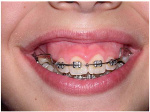Orthodontics Orthodontics
THE ORTHODONTIC
An orthodontist is a specialized dentist. After completing five years of dental studies to obtain a degree in dentistry, he has completed a postgraduate specialization program (usually three years) to obtain the specialty of orthodontics.
FIRST VISIT
During the first visit the patient knows our place, the doctor and his associates. The doctor will do an initial examination to determine if any treatment is needed. If no treatment is indicated immediately, a review will be scheduled after some time. If orthodontic treatment is needed if the time is right for it to start, a new visit will be scheduled.
Full diagnostics will be obtained at the next visit:
- Tooth impressions for making plaster casts.
- Photographs of the patient’s teeth and face.
- Medical history.
- Radiographic examination.
After the study and evaluation of all these data by the doctor, a new visit is scheduled where we present to the parents and the patient the treatment plan, the required time and the cost of the treatment.
Adequate AGE
The official guideline of the American Orthodontic Association and the European Orthodontic Association is that every child should be examined by a specialist orthodontist for the first time at the age of 7 years. He will judge if there is a problem or not and when is the right time to deal with it.
Although the general impression (among many fellow dentists) is that orthodontic treatment should be done in adolescence and when children have all their teeth changed, by the age of 7 orthodontists can diagnose problems with jaw growth or eruption of the teeth and intervene appropriately. Probably, during the first examination it will be found that there is no reason for immediate initiation of orthodontic treatment. Many times, however, there are problems that need to be addressed immediately and even at this age, in order to prevent their deterioration. This is very important because some orthodontic problems are easier to treat if detected and treated early.
The idea that all permanent teeth must have erupted to start orthodontic treatment is scientifically inadequate and unfounded, and can have consequences that are difficult to repair or can lead to the removal of permanent teeth.
The ideal time to start a necessary orthodontic treatment depends on a number of factors (such as the future development of the teeth and bones, the dental and the chronological age of the child), which the orthodontist estimates to determine the optimal time to start treatment of each patient.
ADULT ORTHODONTICS
More than 25% of patients today are adults. Orthodontics is not a privilege of children; no one is too old to be entitled to a beautiful smile! The orthodontist will examine the health of your teeth, gums and bone that hold your teeth together to determine if orthodontic treatment is possible. In addition, if you need other dental work, the orthodontist will work with the other specialties to jointly organize the appropriate time for each work and draw up an overall treatment plan.
Developments in orthodontics now offer you the opportunity to get a healthy and beautiful smile, very discreetly, even without anyone knowing it! Thus, orthodontic treatment will not be an obstacle in your social and professional life. The available orthodontic appliances are the following:
• Transparent ceramic hooks
These are transparent orthodontic mechanisms that make orthodontic treatment very discreet.
• Tongue hooks
They are placed on the inner (lingual) side of the teeth and make the orthodontic treatment 100% invisible.
• Orthodontics with transparent braces.
COST OF TREATMENT
The total cost of an orthodontic treatment depends on factors such as:
- the type and severity (difficulty) of the orthodontic anomaly,
- duration of treatment,
- the type of orthodontic appliances to be used (movable mechanisms, metal or aesthetic or tongue braces or INVISALIGN braces)
The above are determined by the Orthodontist after a detailed examination of the patient and the recommendation of a specific treatment plan and schedule.
The cost of an orthodontic treatment is not such that it is an obstacle to ensuring the health of your teeth and obtaining a beautiful smile. In consultation with you we prepare a financial plan that will facilitate your financial obligations.
TEMPERATURE STRUCTURE PROBLEMS
Adults mainly have frequent headaches that can be due to many causes, such as poor posture, problems in the neck or inner ear, stress and overload of the muscles of the head and face. A patient who has already visited his or her otolaryngologist and has not been able to identify the cause of the problem should visit an orthodontist with knowledge of the physiology and problems of the temporomandibular joint.
The headaches most commonly associated with the temporomandibular joint are headaches from stress and overexertion. They can be chronic or appear periodically as headache episodes, which then go away on their own. They may also be accompanied by other symptoms such as pain in the teeth, ear, face or neck and are often accompanied by sounds from the joint area.
The main cause of headaches due to hypertension due to CKD is the clenching or grinding of the teeth for many hours a day. This can overload the masticatory muscles, mainly, and the rest of the facial muscles, secondarily, and cause the symptoms mentioned above, or others like sounds (cliking) and squeaking from this area.
The treatment of hypertensive headaches varies depending on the specific symptoms of each patient, their intensity and duration. Usually, however, it first involves medication to eliminate the pain, and then a longer-term treatment of the problem with dental braces, physiotherapy exercises and change of daily habits that burden the oral system (gnashing of teeth, chewing, chewing).














